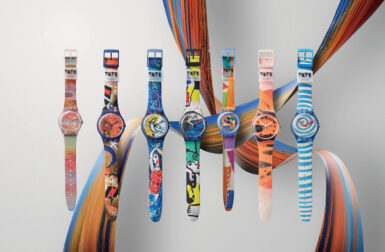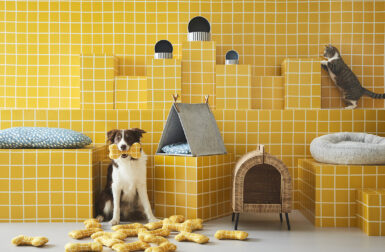Six years ago, Mickey Ashmore created a very special pair of leather shoes – called Sabahs – with the help of a Turkish family of craftsmen. The shoe’s design is based on a traditional shoemaking method that’s celebrated for its quality, comfort, and unique look that only improves with wear. Sabahs are still made by that same family, and are now sold in many Sabah House brick and mortar locations around the world, including New York City, London, Dallas, Los Angeles, Washington, D.C., Amagansett, London – and of course online. Sabah House London is the latest location to open, so we checked out the new space and what’s on the shelves for July’s Design Store(y).
Why did you pick this city/neighborhood/storefront?
We chose London because, well, we love London. It’s a global destination where many of our customers, old and new, pass through (and live!). London is an international crossroads, so having a store there gives us an opportunity to interact with the highest number of our global customers in one city. In the first month, we’ve had customers visit us from Asia, Africa, the Middle East, all over Europe, South America, and even my home town of Dallas!
We chose Chiltern Street because of the neighborhood and our neighbors — sophisticated and independent yet inclusive and humble, quality over quantity, and consisting of many multi-generational family businesses. We wanted to be on a destination block as well, but one that is accessible. And we are honored to be the first non-British retailer on the block, adding our energy into the mix.
Where did you get the name for the store?
Sabah means “morning” in Turkish. I love the morning. And I love the word “Sabah.” It is a word that has meaning in many languages, easy to pronounce, and obviously references Turkey, the source of our inspiration. Each of our stores are called “Sabah Houses + some localization”— in this case, Sabah House 50 Chiltern.
The name Sabah House comes from my first shop being in my own home, a little townhouse on 12th street in the East Village. That was our first and only shop for the first four years of business. It became a real institution of sorts— a destination for folks to come and get a pair of Sabahs, but also connect, engage, and stay a while. We hosted fantastic parties called Sabah Sundays, dinners, backgammon tournaments, live music, speakers, and many, many impromptu social gatherings. Ultimately, I was inviting people into my home so I treated them as exactly that … I’d offer them a drink, a snack, a place to sit, a game of backgammon. I took an interest in who they were, what brought them in, and that usually was word of mouth… so stories ensued. I always say we’re more of a hospitality company than a retailer, we’re very personal and service-oriented and I’m inspired by great service. For us, that is treating visitors as if they are in our home – because they are.
And as for the localization part, each of our stores has very different in feel. They reflect the city, neighborhood, street, and space. They also reflect the mood and whatever inspiration struck at the time of making the place. We want each store to have its own personality and feel like its part of the neighborhood fabric, not a chain. And as such, each has a slightly different name.
Has it changed much since it opened? How?
Well, our Sabah House on Chiltern Street just opened in early May. So, not a lot has changed structurally or physically yet— but we’re excited to be bringing in new art, new merchandise and goods, and new bottles of mezcal and records to enjoy every few months.
If I had to pinpoint a change, it’s the quick and positive accumulation of new friends and an instant community for us in London. Our neighbors have taken to us quickly and we to them. That is a really great thing— opening a shop is not just about sales, it’s about the neighborhood and the value one can bring by way of adding to the neighborhood fabric. This seems to be happening for us in a really nice and organic way on Chiltern Street.
What’s one of the challenges you have with the business?
Where to start… I’d say one of the hardest challenges for our business is building structure and communication processes that keep us all on the same page, informed, and up-to-date. In the last two years, we went from having one Sabah House in the East Village to six across the U.S. and London today (with another on the way). We have many very dedicated, caring, and passionate people who run this business together, but we sometimes struggle to keep everyone connected, informed, and working cohesively. So, we are now building the structure and processes that allow us to maintain our independent approach, our familial nature, our quirkiness, and art, while also making sure everyone is effective at their job, which is ultimately providing great service and great shoes to our customers!
What other stores have you worked in before opening this one?
Retail is all new for me and most people in my business, which has worked to our advantage, because in many ways we’ve charted our own course and not done things by the book. Before Sabah, I worked for Microsoft in Seattle and then Istanbul. I always loved markets, shopping when I traveled (who doesn’t!?), and hospitality. I recognized my favorite shopping experience was in-person and often a little messy, very real, not designed to sell but more the expression of the person who was selling. I think that is authenticity — when the objective of the person, space, or business is not to sell or to build community, but to express something else and the by-product is sales, community, etc. A lot of that is missing these days in retail and business in my opinion.
What’s your favorite item in the store right now?
Well, that’s a tough one. I’m fondest of our Sabahs in our very own signature Sabah Blue. It’s a color we developed with a small tannery in Istanbul, exclusive to Sabah. It is beautiful, versatile, and ages wonderfully. Additionally, we have artwork by two fantastic London-based artists for sale in the shop; one piece by Jonathan Schofield and the other by Tom Jean Webb; the latter commissioned for the space. Both are large in scale, beautiful, and also affordable, which I appreciate.
What is this season’s theme/inspiration/story?
This year we have shifted our focus to finding the best small tanneries in Turkey with passionate owners, and investing in R&D with them to develop fully vegetable tanned and/or semi-vegetable tanned leathers made with sustainable methods. We believe not only is it better for the world and all stakeholders in our supply chain, but it also results in an even better pair of Sabahs. This has been a major investment of time and resources on our behalf as Turkey has a very limited market of tanneries working in this manner, but we are really excited about the direction and try to think more and more long-term with our decision-making around product as our business grows. As such, our Fall collection will be almost entirely vegetable tanned leathers made exclusively for Sabah, developed in partnership with two small family run tanneries. That makes me really excited!
Are you carrying any new products and/or undiscovered gems you’re particularly excited about?
This year, we started to offer Sabah belts. They are all handmade in El Paso, Texas in a small workshop operated by a father and son for about 30 years, and are one of the best belt makers in the world. We’ve been importing our newly developed Sabah leathers to make the belts: Texas meets Turkey. We are about to release belts in Sabah Blue and our signature Leopard hair-on leather. They arrive in London next week. The Sabah Blue belt is awesome—what a great subtle pop of color.
What’s been a consistent best seller?
We can’t keep our Leopard Sabahs and Babas in stock. They are made using a really high-quality printed cow hair leather. It’s a beautifully executed print and a very versatile, beautiful pair of shoes. We see people using them as a regular, daily Sabah or as a special occasion pair, especially guys pairing them with summer suits.
What’s your process for selecting + curating the objects in your shop?
Mania!? There’s a quote by the artist Chuck Close, which I really like that I think captures my approach (for better and for worse) pretty well. I’ve shortened it below.
“The advice I like to give young artists is… not to wait around for inspiration. Inspiration is for amateurs; the rest of us just show up and get to work … All the best ideas come out of the process; they come out of the work itself. Things occur to you. If you’re sitting around trying to dream up a great art idea, you can sit there a long time before anything happens. But if you just get to work, something will occur to you and something else will occur to you and something else that you reject will push you in another direction. Inspiration is absolutely unnecessary and somehow deceptive. You feel like you need this great idea before you can get down to work, and I find that’s almost never the case.”
Any special events/exhibits/pop ups/collaborations coming up?
We are working on that now. We are hosting a Block Party on Chiltern Street with all the other retailers on the block on June 24 — every shop is going to be serving a different spritz. It’ll be a lively summer evening. And then we’re planning to utilize our basement level space for something, but right now we’re just getting our basic rhythms in place with the fun events and things to follow!
Do you have anything from the store in your own home?
You bet! A multitude of Sabahs and Babas are found all over my house as well as all of our other products. We burn a really great Palo Santo resin in our stores made by Incausa from Brooklyn. I burn this in my home, too.
What’s been one of the most fulfilling aspects in opening your store?
Working with all the different craftspeople, workers and, in this case, our local design collaborator Anna Burns. We had a really talented, hardworking, and FUN crew for this job. We were together for about 10 days non-stop. Lots of laughs, hard work, and collaboration. The woodwork was done by two brothers who are the two finest woodworkers I’ve ever used… and we’ve built a lot of custom furniture and built-ins over the years. They were true artisans.
What’s one lesson you’ve learned since opening your store?
People like to congratulate us when we open a store. I’d argue opening a store is the easy part. Congratulate me when it’s been open for a year or more and it’s profitable! That’s the hard part — operating a store successfully.
If you could give one piece of advice to someone who wants to follow a similar path to yours, what would it be?
Express yourself and your ideas/interests/DNA with your business, approach, concept, and space. Don’t design, build, or concept to appeal to others, trends or what you think the customer wants. I think the former is far more interesting for the world and will, over the long-term, yield a much strong reaction and loyalty. So it’s ultimately better business too.
Also, remember that a lot of small crumbs can make a very nice cake. When I started my business, I hustled for every little sale, put a lot of emphasis on personal interactions, and followed up with individuals. I like to say that I shook the hands personally of our first 10,000 customers. I think that is 100% accurate. It took a lot of effort, energy and time, but it has made the difference today. And I loved every second of it!
Visit Sabah House London at 50 Chiltern Street Marylebone, London, UK W1U &QT, any of their U.S. locations, or sabah.am.































